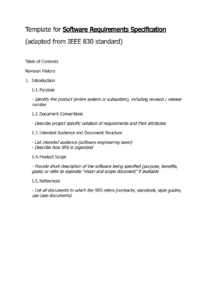Creating comprehensive software requirements specifications is crucial for ensuring that the final product meets the needs of stakeholders. A well-written software requirements specifications template can help you organize and document all necessary requirements, paving the way for a successful software development project.
When selecting a software requirements specifications template, it’s essential to consider factors such as the software’s complexity, project team size, and regulatory requirements. There are various templates available online, and choosing one that aligns with your specific needs will help streamline the requirements gathering process.
Importance of a Comprehensive Template
A comprehensive software requirements specifications template ensures that all necessary aspects are covered, including functional requirements, non-functional requirements, user interface requirements, data requirements, and quality attributes. It provides a structured framework for documenting requirements, facilitating collaboration among stakeholders, and reducing the risk of misunderstandings or omissions.
A well-organized template allows you to capture detailed information about each requirement, including its source, priority, and acceptance criteria. By adhering to a consistent format, you improve the readability and traceability of requirements, making it easier for developers to implement and testers to verify them.
Moreover, a comprehensive template helps manage changes to requirements throughout the development process. It provides a central repository where updates can be tracked and communicated effectively, ensuring that the software remains aligned with stakeholder expectations.
Sections of a Standard Template
Standard software requirements specifications templates typically include the following sections:
1. Introduction: Provides an overview of the document, including its purpose, scope, and intended audience.
2. Glossary: Defines important terms used in the document.
3. Functional Requirements: Describes the specific tasks and functionalities that the software must perform.
4. Non-Functional Requirements: Specifies constraints and quality attributes such as performance, reliability, and usability.
5. User Interface Requirements: Outlines the design and layout of the user interface.
6. Data Requirements: Identifies the data that the software will use and process.
7. Quality Attributes: Defines the desired quality of the software, including maintainability, portability, and security.
Conclusion
Choosing the right software requirements specifications template is essential for creating a comprehensive and effective document. By using a template that aligns with your project needs, you can streamline the requirements gathering process, improve communication among stakeholders, and ensure that the final product meets expectations.
Remember to involve stakeholders throughout the process to ensure that all their requirements are captured and accurately documented. A well-written software requirements specifications template will serve as a solid foundation for a successful software development project.

